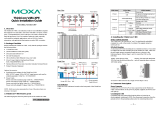
UC-2100 Series Introduction
Overview
The UC-2100 Series computing platform is designed for embedded data acquisition and processing applications.
The computer comes with up to two software-selectable RS-232/422/485 full-signal serial ports and single or
dual Ethernet LAN ports. In addition, the RISC computing platform is available in various models that can fulfill
diverse interface requirements, such as single and dual serial, LAN ports, and Gigabit Ethernet and wireless
connections. These versatile communication capabilities let users efficiently adapt the palm-sized UC-2100
computing platform to a variety of complex communications solutions.
Model Descriptions
The UC-2100 Series includes the following models:
• UC-2101-LX: Palm-sized industrial computing platform with 1 serial port, 1 Ethernet port, -10 to 60°C
operating temperature
• UC-2102-LX: Palm-sized industrial computing platform with 2 Ethernet ports, -10 to 60°C operating
temperature
• UC-2104-LX: Palm-sized industrial computing platform with 1 mini PCIe socket for wireless module, 1
Ethernet port, -10 to 70°C operating temperature
• UC-2111-LX: Palm-sized industrial computing platform with 2 serial ports, 2 Ethernet ports, Micro SD
socket, -10 to 60°C operating temperature
• UC-2112-LX: palm-sized industrial computer with 1 GHz processor, 2 serial ports, 2 Ethernet ports (1
gigabit Ethernet), Micro SD socket, -10 to 60°C operating temperature
• UC-2112-T-LX: Palm-sized industrial computing platform with 1 GHz processor, 2 serial ports, 2 Ethernet
ports (1 gigabit Ethernet), Micro SD socket, -40 to 75°C operating temperature
Package Checklist
Before installing a UC-2100 computer, verify that the package contains the following items:
• UC-2100 Series computer
• Console cable
• Power jack
• Quick Installation Guide (printed)
• Warranty card
NOTE: Notify your sales representative if any of the above items are missing or damaged.
Product Features
• Armv7 Cortex-A8 600 1000 MHz processor
• 1 to 2 auto-sensing 10/100 Mbps Ethernet ports (Gigabit Ethernet supported on UC-2112 models)
• Up to 2 software-selectable RS-232/422/485 ports supporting all signals
• Moxa Industrial Linux with 10-year superior long term support
• Mini PCIe socket for Wi-Fi/cellular module (UC-2104)
• Micro SD socket for storage expansion (UC-2111/UC-2112)
• -40 to 75°C wide-temperature models available
For a complete set of specifications, refer to the product datasheet available on the Moxa Website.






















